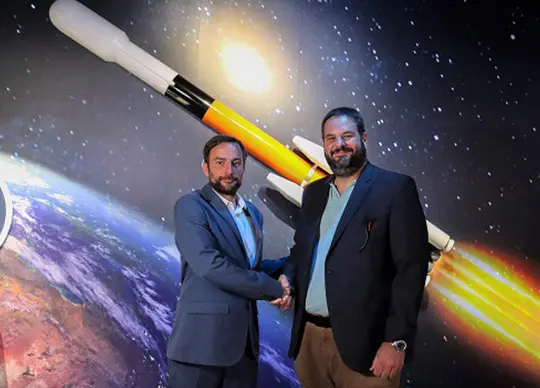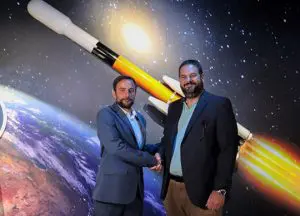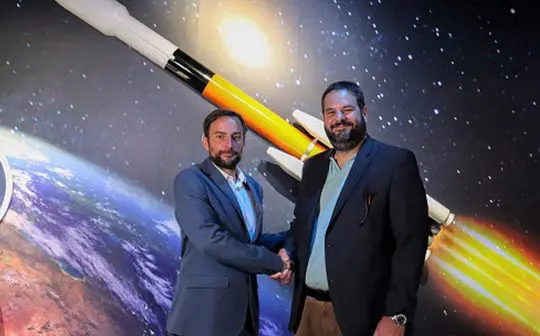

Images: Associate Professor Rodrigo Praino, right, and Marco Aliberti, Associate Manager and International Engagement Lead at ESPI, are pictured recently at the Australian Space Discovery Centre in Adelaide.
Associate Professor Praino outside SA Parliament House, Adelaide.
The expanding use of outer space for human activities requires increasing attention to policies and governance, with a Flinders University space expert warning of an increasing need for a well-developed strategic plan to manage competing national interests.
In a new publication, Associate Professor Rodrigo Praino says the race to explore and possibly settle the Moon, Mars and control satellite communications is just part of the race to gain power in space.
“Space science and technology is racing ahead at a rate faster than knots, so it’s important that work steps up in the international relations and decision-making sphere,” he says.
“Starting with the latest lunar exploration endeavours, there seems to be a more competitive approach towards a progressive polarisation of the international space community around two separate and potentially conflicting blocs.
“We need to build more open communications around the growing competition dynamics between the three leading space powers, the United States, Russia and China – both with the return of human flights to the Moon and other initiatives of the space superpowers,“ says Associate Professor Rodrigo Praino, who leads the Space Power and Policy Applied Research Consortium (SPPARC) at Flinders University.
Power, State and Space – Conceptualising, Measuring and Comparing Space Actors (Springer) makes comparative assessments of the activities of most of the active ‘space actors’ – led by the US, China and Russia and followed by others such as Europe, India, Canada, Japan, South Korea, Israel, Australia and Brazil.
The data confirms the rise in China as a full-fledged space power, now in the same league as the US and Russia, and accumulating a series of incredible feats and achievements that will enable it to pursue even higher space ambitions in the upcoming decade, the analysis concludes.
The new evaluation of ‘spacepower’ and ‘space power status’ will play an important role in 21st century political, military, commercial and technological change and competition.
“The competition between China and the US emerges as the dominant scenario.
“This leaves Europe – at a distant fourth place – and countries such as Japan, India and Australia in need to plan to increase their space capacity and autonomy to catch up to the political and technical abilities of the dominant space powers,” says Associate Professor Praino.
A recent report by KPMG and the American Chamber of Commerce estimated Australia could see more than 1300 lucrative specialised jobs and $US400 million in exports within 10 years from the space sector. It would include key trade, investment and skilled employment partnerships with the US in AI, digital economy, quantum computing, biotechnology and space science, energy and clean technologies.
The UN International Day of Human Space Flight was declared on 12 April to celebrate international contribution of space science and technology in achieving sustainable development and to ensure the maintenance of outer space for peaceful purposes.
Russian cosmonaut Yuri Gagarin carried out the first human space flight to the Moon on 12 April 1961.
Flinders University space experts have also contributed to a new book, Human Uses of Outer Space (2023), including a chapter ‘Back to the Moon: Cooperation and Conflict’ by Marco Aliberti, Vincius Guedes Gonçalves de Oliveira and Rodrigo Praino





